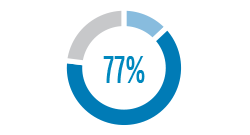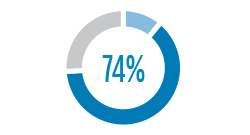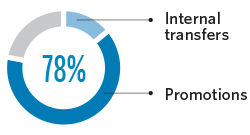Succession Plan 2018-22
Introduction
Succession planning is a critical component of workforce planning. It is a practice that experts consider foundational and a sound investment for any organization intent on long-term success. The objective of workforce planning and succession planning is to have the right person, with the right skills, in the right job, at the right time. This document will focus on succession planning, which refers to the efforts undertaken to develop all leaders in the organization.
For more than 20 years, CalPERS has been committed to supporting leaders to reach their full potential in their current role and develop their skills for future opportunities of greater scope and responsibility. The emphasis on developing and investing in our leaders supports two of our organization's strategic goals: Cultivate a risk-intelligent organization and Promote a highperforming and diverse workforce. Placing a continuous focus on retaining and developing our leaders benefits the organization in the short-term by fostering engagement as well as in the long-term by ensuring internal candidates are strong competitors for key position vacancies. Our succession planning efforts include development opportunities for all current and aspiring leaders, and range from formal programs, to classroom training, to informal mentoring.
Terminology
CalPERS has approximately 560 leaders in roughly 45 classifications. For ease of administration, we group all classifications based on organizational hierarchy into four types of leaders. The titles below will be used throughout this document to identify specific leader populations.
- 1. Unit/Team Leader
-
- First level of leadership
- 2. Section Leader
-
- Leader of leaders
- 3. Division Leader
-
- Leader of a division, and
- Direct report to a Branch Leader, and
- Career Executive Appointment, Chief Operating Investment Officer, or Managing Investment Director classification
- 4. Branch Leader
-
- Leader of multiple divisions, and
- Direct report to Chief Executive Officer, and
- Career Executive Appointment, Chief Actuary, Chief Financial Officer, Chief Investment Officer, or General Counsel classification
Leadership Competencies
Leadership competencies are the cornerstone of succession planning at CalPERS. Our model includes seven competencies and four distinct sets of behavioral statements for each. This structure offers a clear picture of what is expected of leaders in their current role as well as what they should work toward for a future role of greater responsibility.
CalPERS Leadership Competencies:- Business Acumen
- Collaboration
- Communication
- Driving Results
- Leading Change
- Leading People
- Leading Self
These competencies are used in our succession planning program and are also being incorporated into all other development offerings. We have a long-range plan to integrate the competencies into the talent lifecycle so we can link and align hiring, development, evaluation, and rewards.
The Data
The largest workforce population at CalPERS is Generation X (46 percent) with Millennials (31 percent) a close second, and Baby Boomers, third (23 percent). Gen Xers represent 60 percent of the leadership population, baby boomers represent 27 percent, and millennials represent 11 percent. The number of baby boomers in leadership roles is proportionate to the total population, while Gen X and millennials are not.
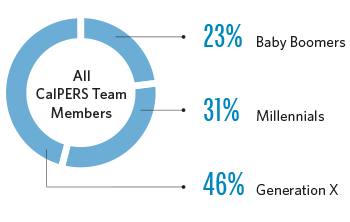
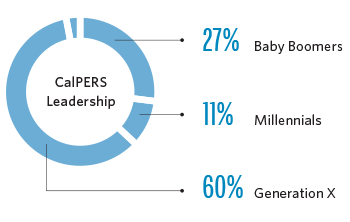
It seems like we don't hear much about Gen Xers, with focus on the slowly retiring baby boomers or ascending millennials, who are expected to be 75 percent of the global workforce population by 2025. In a 2018 Global Leadership Forecast, Development Dimensions International found that Gen X leaders remain loyal employees and only 37 percent contemplate leaving to advance their careers — five percentage points lower than millennials. They want traditional learning methods, such as: formal workshops, training courses, and seminars, but also enjoy the convenience of technology-based tools. As our largest population of leaders, focusing on strengthening the skills of Gen X leaders and further developing them is essential.
According to Gallup, millennials fundamentally think about jobs as opportunities to learn and grow. Their fervent desire for development is, perhaps, the greatest differentiator between them and all other generations in the workplace. An impressive 87 percent of millennials rate "professional or career growth and development opportunities" as important to them in a job — far more than 69 percent of non-millennials who say the same. We believe it's critical that we enhance and evolve our learning and development strategy to build more leaders from this generation and bridge the gap so millennials are more proportionately represented in leadership.
Succession Planning Tactics
CalPERS employs many tactics in its succession planning strategy. These tactics include: classroom training, informal mentoring, leadership forums, an emerging leader program, leadership coaching, and a succession planning program. Each is described in the following sections.
Classroom Training
Our programs and courses are recognized as industry best practice and developed by human resources professionals, CalPERS subject matter experts, and faculty from the University of California, Davis Extension. The Progressive Leadership Series, comprised of three learning tracks (Leadership Essentials And Direction for your Emerging Role, Lead by Example, and Maximum Results) and anchored in the CalPERS leadership competencies, was designed to help to develop our leaders at each stage in their career. Our curriculum also satisfies State of California Government Code 19995.4 in support of professional development.
Leadership Essentials And Direction for your Emerging Role (LEADER) provides foundational management and leadership skills for our unit/team leaders. Section and division leaders who are new to CalPERS or state service are also required to attend.
Lead by Example helps unit/team, section, division, and branch leaders understand leadership styles, improve day-to-day planning techniques, and leverage proven strategies to develop teams to their full potential.
Maximum Results helps unit/team, section, division, and branch leaders further define their leadership values and strengths, and provides strategies, such as: developing dynamic teams, applying "Level 5" leadership principles, utilizing a rigorous strategic planning model, and developing collaborative relationships.
These one-day classes are offered to supplement and provide continual learning for unit/team, section, division, and branch leaders to help them develop in areas of interest or need. Courses may include: Becoming a Change Agent, Leading with Values, Cultivating Powerful Leadership Presence, Situational Leadership, and Solutions Focused Thinking. Course offerings are evaluated each year to ensure both individual and organizational needs are being met.
Informal Mentoring
Mentoring plays a key role in CalPERS culture. Our approach facilitates informal mentoring in all directions, regardless of career level. Participants broaden their knowledge of the organization and its functions through sharing with one another. Mentoring helps to increase employee retention, enhances professional and personal development, facilitates cultural reinforcement, and encourages organizational diversity. As part of the leadership development program, group leadership mentoring sessions offer team leaders the opportunity to engage with private and public-sector leaders in a more structured setting. This further contributes to the goal of the program: to initiate thought-provoking dialogue among leaders, with exposure to multiple viewpoints and cross-disciplinary perspectives.
While mentorship is a necessary component of talent development, the guidance, advice, and perspective exchanged through this relationship is not always enough. The executive leadership team has identified the act of sponsorship as a key additional layer and will be making it a priority and an intentional practice. Executive sponsors take mentorship one step further – they use their influence, credibility, and social capital to advocate for the leader they're sponsoring. They are in a position where they can directly provide opportunities for growth, exposure, and career advancement.
Leadership Forums
Leadership forums play a key role in our leadership development strategy and help cultivate a highly competent and cohesive leadership team. The forums are generally development-focused and provide unit/team, section, division, and branch leaders with networking opportunities and updates from the executive team up to four times per year.
Emerging Leader Program
Acknowledging the makeup of our workforce and their needs, we developed an Emerging Leader Program pilot in 2017 to prepare high-performing analysts to successfully compete for team leader roles. The Emerging Leader Program aims to provide participants a framework to develop and practice leadership skills, and encourages them to feel inspired and committed to their own leadership journey. Over six months, 25 aspiring leaders applied leadership behaviors to real work challenges and were introduced to leadership competencies necessary for building credibility, engaging team members, and creating an attitude and process for an innovative mindset. To ensure success in the program, participants received a network of support from a team leader, mentor, and accountability partner.
We are in the process of assessing the findings of this pilot program, but early indications show it was very successful. Preliminary results tell the following story (based on a percentage of participants):
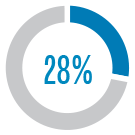
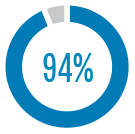
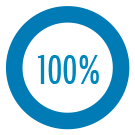
The feasibility of offering this program as an ongoing leadership development opportunity is currently being evaluated.
Leadership Coaching
One-on-one coaching can be a very effective means to support and accelerate development of effective leadership behaviors, and CalPERS provides division and branch leaders with external professional coaches on an ad-hoc basis. With the success of and demand for professional coaching as a component of leader development, we realized there was an opportunity to build the coaching capability internally. This approach would be a cost-effective way to make coaching available to a greater number of leaders at all levels and would supplement external coaching offered at the division and branch leader level. At the end of 2017, two members of the Leadership Development Team completed the University of California, Davis Extension Professional Coaching for Life and Work certificate program. This rigorous 150-hour program provided the necessary foundation for these individuals to coach with credibility, as well as begin the journey to earn International Coach Federation credentials. A soft-launch of internal coaching commenced in 2018 and a more formal plan that scales this offering will be developed by the end of the calendar year.
Succession Planning Program
The Succession Planning Program focuses more narrowly on developing and preparing section and division leaders to successfully compete for key leadership positions. We've taken a broad approach to identifying key leadership positions and consider all division leader and branch leader positions critical in leading the organization to carry out our mission. The program offers a means to reveal strengths and gaps in a leader's proficiency in the leadership competencies so energy can be focused on building proficiency through targeted development activities. The focus is on helping individual leaders identify and address their development goals.
The program is designed to best serve section and division leaders who are achieving success in their current role, have the desire to lead in a more strategic role, are strongly committed to developing their skills, and are open to new experiences. Role and classification are both considered in determining which positions are eligible to participate. More than 100 individuals within 11 classifications meet these criteria, which is detailed below.
Leadership Positions Eligible to Participate in the Succession Planning Program:
Section Leader — Direct report of a division leader and is one of the following classifications:
- Career Executive Appointment
- Financial Accountant IV
- Health Program Manager III
- Information Technology Manager II
- Investment Director
- Medical Consultant II
- Research Manager III
- Research Scientist Supervisor I
- Research Scientist Manager
- Staff Services Manager III
- Supervising Management Auditor
Division Leader — Oversees a division and is one of the following classifications:
- Career Executive Appointment
- Chief Operating Investment Officer
- Managing Investment Director
On an annual basis, our Human Resources Division connects with each leader in an eligible position that isn't participating in the Succession Planning Program. There is a conversation about the leader's current state and career goals, along with an exploration of how the program could further their development. If the individual elects not to participate, they are still part of the pipeline due to their position, and may still promote.
Eligible leaders initiate program participation by notifying human resources of the leadership position to which they aspire. Human resources works with the leader's manager to determine whether this is the right development opportunity and the right time, based on performance and potential. This process is facilitated through a 9-box tool, which is a best practice in succession planning, and asks the manager to consider the extent to which they agree with statements about the leader's performance and potential. If the leader's manager determines it isn't the right time for the leader to participate, other appropriate development activities that can be undertaken are determined. The leader can always join the program in the future when the timing is right. Those who are admitted to the program go through the process outlined in the following sections.
Program participants undergo a 360° assessment using a web-based tool created by the HR research and advisory firm, McLean & Company. Feedback is gathered from self, manager, direct reports, peers, and other stakeholders, so the participant gets a well-rounded and complete baseline of proficiency in the leadership competencies needed for the level of the leadership position to which they aspire.
Upon conclusion of the 360° assessment, human resources facilitates a debrief and development conversation with the participant and their manager. They review the quantitative ratings and written feedback regarding each of the seven competencies, which provide insights into gaps the participant should focus on closing. The extent of development needed is considered and a determination is made as to the approximate number of years until the participant would have the experience needed to be ready to compete and be successful in the role.
Our program utilizes individual development plans to demonstrate how participants will close gaps in competency proficiency and accelerate their readiness for a promotional opportunity. The participant, their manager, and human resources identify customized experiences that will challenge and stretch the leader's capabilities and give them exposure that might not be available in the scope of their current role. The participant documents their development goals, time frame, methods to achieve those goals, and others involved, in a formal plan. Following the best practice for leadership development set forth by the Center for Creative Leadership, we recommended participants focus 70 percent of their development on challenging assignments, 20 percent on relationships, and 10 percent on coursework. Examples of challenging assignments include:
- Building a cross-functional team to tackle a common business issue or problem
- Integrating diverse systems, processes, or procedures across decentralized units
- Handling tough negotiations with an internal or external stakeholder or business partner
- Serving as a champion for an organization-wide change or new initiative
- Spending time with an expert to learn something in a new subject
- Joining or chairing a committee
- Presenting at a conference or event
- Getting involved in strategy development
- Participating in a board of administration presentation or workshop
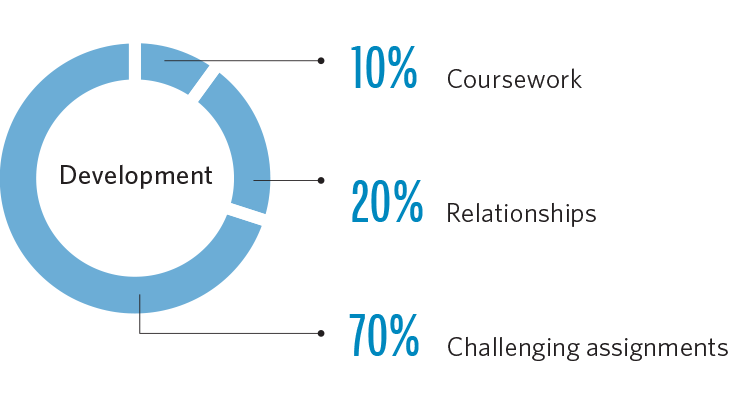
Throughout the year, the participant executes their development plan with coaching and feedback provided by their manager and any others designated as mentors, and attends check-ins with human resources. After 12 months, their proficiency is re-evaluated and their development plan is adjusted as necessary.
Assessment of Succession Planning Strategy
Successes & Promotions
Emerging Leader Program
Twenty-eight percent of participants in the Emerging Leader Program have received promotions during the pilot to date. Although this is impressive, success is not merely measured by the number of promotions alone. Additional successes include positive mentor/mentee relationships, increased interaction between the participant and their team leader regarding career aspirations and goals, and ongoing accountability partnerships. The participants have also gained a greater level of self confidence in their leadership abilities that will serve them in their current and future roles within the organization.
Succession Planning Program
In fiscal years 2015-16 and 2016-17, we appointed a total of three new branch leaders; two of these individuals were participants in the Succession Planning Program. With the expansion of the program in the second quarter of fiscal year 2016-17 to include developing future division leaders, we have already seen success. As of the third quarter of fiscal year 2017-18, we've appointed eight new division leaders, including two individuals who were participants in the program.
Internal Hire Rate
Our internal hire rate average of 76 percent for leadership positions over the past three fiscal years indicates we are preparing our team members and team leaders to successfully compete for their first leadership role or for a more advanced leadership role.
Interim Leadership During Key Leadership Position (Division and Branch Leader) Vacancies
In the time between a key leadership position becoming vacant and a new leader being appointed into that vacancy, the primary functions and leadership responsibility of that position still need to be carried out. Interim key leadership position assignments are made available to leaders at the same level, one level below, or one level above. We've had success in maintaining stable operations despite vacancies at the division and branch leader level because there's always someone with sufficient knowledge and ability to take on the job in an interim capacity. We credit this to the fact that our culture encourages knowledge sharing and informal mentoring.
Risks and Responses
Learning Curve of New Division Leaders
Over the last three fiscal years, 43 percent of our vacant division leader positions have been filled by internal candidates who are familiar with the organization's culture, norms, and structure. When we don't have a competitive internal candidate or the business need would be best served by hiring someone with outside perspective and experience, we hire an external candidate. Anytime the occupant of a key leadership position changes, there is risk to continuity of operations. When the new leader is an external hire, they must learn their job, as well as how to navigate the organization. When the new leader is an internal hire, they already have great familiarity with the organization, but will need to understand the nuances at their new level. They may have more familiarity with their new job than an external hire, but still have much to learn. While this learning happens naturally over time, it takes time for the leader to be fully effective in their job. To limit the risk to business operations, we aim to reduce the learning curve through customized senior leader onboarding. An onboarding plan is typically created in partnership with the new division leader's manager and the Leadership Development Team. The lightly-structured and fluid process occurs over the span of their first few months and connects them with people and information most critical to enabling their success. Again, CalPERS' culture of knowledge sharing and informal mentoring contributes to the success of this process. This effort wouldn't be successful without the willingness of leaders to share information with new leaders
outside of their function.
Challenges
Competing Priorities
Based on what we hear from leaders, one of the ongoing challenges we face in succession planning is balancing workload with time for development. Investing in one's own development and being a steward of the development of other leaders in the organization is undoubtedly part of our culture and unanimously considered important, but can be perceived as costly when viewed through a short-term lens. However, long-term, the cost of not doing it is even greater. Some leaders have expressed that because they are always "doing," they don't have time to reflect, which is an important part of the development process. For example, attending a one-day training class and then jumping immediately back into the job doesn't support application and reinforcement of new concepts. Participating in a stretch assignment and then going immediately back to other responsibilities doesn't allow the leader to fully absorb their experience and takeaways. Additionally, timely and valuable coaching opportunities can be missed because we are moving so quickly.
Action Plan
We have a very mature and comprehensive succession planning strategy, as outlined in this document. To support continued success in developing and retaining leaders, the following actions are planned:
- Incorporate leadership competencies into talent acquisition and performance evaluation for all leaders
- Roll-out internal leadership coaching services
- Hold more comprehensive discussions with candidates selected for division and branch leadership positions about compensation and benefits as part of the pre-boarding process
Conclusion
Succession planning is a defining aspect of CalPERS culture where leaders are empowered to grow and develop. CalPERS knows that our succession planning challenges must be recognized and managed. We know that succession planning takes time and patience. We know that we need to provide opportunities for our leaders to learn so they can be ready to advance when the opportunity arises. CalPERS is committed to staying focused on our workforce and succession planning needs.
